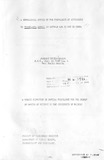| dc.description.abstract | Toxoplasmosis is a widespread zoonotic disease, caused by a protozoan parasite, Toxoplasma gondii. Toxoplasma infections have been recorded all over the world in most of the domesticated and wild animals, birds and man. Man can acquire the disease by ingestion of sporocysts from infected cats or from the ingestion of inadequately cocked meat of infected food animals.
Toxoplasmosis is a relatively uncommon clinical disease, although some of its manifestations are serious. Congenital toxoplasmosis is a medically and economically important disease, in both human beings and animals. In younger animals, toxoplasmosis may be fatal, causing considerable economic losses in sheep and goats.
Only limited studies on Toxoplasma infection have been carried out in domestic animals and man in Africa. Hie prevalence of
Toxoplasma infection in Kenya is not known with certainty, and only
a few records have been found concerning the prevalence of the
infection in animals and man in this country.
The main objective of the work described in this thesis was to provide some data cn the prevalence cf loxoplasma gondii infection
in some animal species and in man in Kenya.
The Sabin and Feldman dye test (DT) has been considered the most reliable method for the detection of antibodies to Toxoplasma, and is still used as a reference test for comparison with other methods. In recent years, an enzyme immunoassay (ELISA) has been adapted as an adequate and more easily performed alternative method.
The ELISA was used in this study for the detection of antibodies to Toxoplasma in random serum samples from goats, sheep and man. Antigen preparation consisted of peritoneal fluid from mice infected experimentally with live virulent tachyzoites of the RH strain of T. gondii.
It was anticipated that the use of a crude non-purified antigen preparation which contained mouse serum components, especially mouse immunoglobulins, might give rise to false
positive reactions in ELISA. Immunodiffusion and imrnunoelectrophoresis
, experiments revealed that anti-sera produced against the igG of %
one species would react with immunoglobulins of other species, including mouse immunoglobulins. Since mouse immunoglobulins present in the Toxoplasma antigen preparation would adsorb to the plastic plates used in the ELISA, it was found that anti-sera to goat, sheep and human IgG had to be absorbed with mouse serum
before species specific enzyme - conjugates lacking antibody activity mouse immunoglobulins could be prepared. In most cases the IgG fraction obtained by DEAE - cellulose chromatography of an absorbed antiserum was used for the preparation of enzyme conjugates, but purified antibodies were also occasionally used to obtain conjugates with high antibody activity and specificity. In addition, normal mouse serum was added to the conjugates to abolish all antibody activity to mouse immunoglobulins.
Although the procedures outlined above resulted in a
considerable decrease in false positive reactions - a
conclusion based on the absence of reactions by these conjugates
when tested on plates coated with dilution of normal mouse .
peritoneal fluid or mouse serum - two additional factors were • considered crucial to achieving maximum specificity for Toxoplasma antibodies. Firstly, the mouse immunoglobulins adsorbed to the plates might possess antibody activity to the immunoglobulins of the species whose serum was being tested in ELISA. Secondly, the test serum might possess antibody activity
to mouse immunoglobulins adsorbed to the plates. In both cases,
false positive reactions would be observed. It was found that addition of normal mouse serum to the diluent used for the test serum samples almost completely abolished these reactions.
Further experiments were carried out to define optimal conditions for the ELISA. Particular attention was paid to the diluents used for conjugates and serum samples, as well as to the diluent used for the coating of the places with crude antigen. The diluents found to be optimal in this study differ considerably from those described in the literature.
Using this ELISA system a comparative study was performed using serum samples with known DT titres. A total of 13 human sera and 11 goat sera were found to give ELISA values which correlated 'with the DT titres, 92% and 100% respectively, while
the correlation was only 44% for 9 serum samples from sheep.
The possibility of cross-reactions due to infections with parasites possessing antigen(s) in common with T. gondii was not extensively examined although an obvious need exists for- such investigations. The only relevant experiment performed was to investigate if hydatid cyst and Cysticercus bo vis antigens were
capable of reducing the ELISA values in 9 human serum samples
with known DT titres. The results showed that no crossreactions
occured between Toxoplasma antigens and those of ' hydatid cyst fluid and C. bovis, as no reduction in ELISA values were found. Hydatidcsis, a common condition of small ’ stock in Kenya should therefore not give rise to false positive results in ELISA.
When this ELISA system was used in a survey for antibodies to T. gondii in random serum samples from 155 goats, 158 sheep and 214 human blood donors, prevalence rates of 21%, 56% and i*3£ respectively were found. While some caution must be exercised in the interpretation of the prevalence rate found in sheep, due to the low correlation between the DT and ELISA, the results obtained with goat and human serum samples should provide a reasonably accurate reflection of Toxoplasma infection in these populations. The results are largely in accordance with prevalence rates found in other parts of the world.
The high prevalence rates of Toxoplasma antibodies in goats and sheep indicate that these animals may play an
important role m che epidemiology of Toxoplasma infections.
To identify the epidemiological factors of importance for
maintaining the widespread distribution of the parasite,
it is suggested that further investigations should be carried
out on other common slaughter animals, domesticated
animals and wildlife in Kenya. | en_US |



